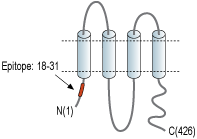Overview
- Peptide (C)KEPTEPKFKGLRLE, corresponding to amino acid residues 18 - 31 of human PANX1 (Accession Q96RD7). Intracellular, N-terminus.

Pannexin 1 Blocking Peptide (#BLP-CC234)
 Western blot analysis of rat brain lysate (lanes 1 and 4), mouse brain lysate (lanes 2 and 5) and small intestine lysate (lanes 3 and 6):1-3. Guinea Pig Anti-Pannexin 1 Antibody (#ACC-234-GP), (1:400).
Western blot analysis of rat brain lysate (lanes 1 and 4), mouse brain lysate (lanes 2 and 5) and small intestine lysate (lanes 3 and 6):1-3. Guinea Pig Anti-Pannexin 1 Antibody (#ACC-234-GP), (1:400).
4-6. Guinea Pig Anti-Pannexin 1 Antibody, preincubated with Pannexin 1 Blocking Peptide (#BLP-CC234).
 Expression of Pannexin 1 in rat hippocampus.Immunohistochemical staining of perfusion-fixed frozen rat brain sections with Guinea Pig Anti-Pannexin 1 Antibody (#ACC-234-GP), (1:300), followed by goat anti-guinea pig - Alexa Fluor-594. A. Staining in the rat hippocampal dentate gyrus region, showed Pannexin 1 immunoreactivity (red) in the granule layer (G) and in hilar interneurons (arrows). B. Pre-incubation of the antibody with Pannexin 1 Blocking Peptide (#BLP-CC234), suppressed staining. Cell nuclei are stained with DAPI (blue).
Expression of Pannexin 1 in rat hippocampus.Immunohistochemical staining of perfusion-fixed frozen rat brain sections with Guinea Pig Anti-Pannexin 1 Antibody (#ACC-234-GP), (1:300), followed by goat anti-guinea pig - Alexa Fluor-594. A. Staining in the rat hippocampal dentate gyrus region, showed Pannexin 1 immunoreactivity (red) in the granule layer (G) and in hilar interneurons (arrows). B. Pre-incubation of the antibody with Pannexin 1 Blocking Peptide (#BLP-CC234), suppressed staining. Cell nuclei are stained with DAPI (blue). Expression of Pannexin 1 in mouse cerebellum.Immunohistochemical staining of perfusion-fixed frozen mouse brain sections with Guinea Pig Anti-Pannexin 1 Antibody (#ACC-234-GP), (1:300), followed by goat anti-guinea pig - Alexa Fluor-594. A. Pannexin 1 immunoreactivity (red) appears in purkinje cells (arrows). B. Pre-incubation of the antibody with Pannexin 1 Blocking Peptide (#BLP-CC234), suppressed staining. Cell nuclei are stained with DAPI (blue).
Expression of Pannexin 1 in mouse cerebellum.Immunohistochemical staining of perfusion-fixed frozen mouse brain sections with Guinea Pig Anti-Pannexin 1 Antibody (#ACC-234-GP), (1:300), followed by goat anti-guinea pig - Alexa Fluor-594. A. Pannexin 1 immunoreactivity (red) appears in purkinje cells (arrows). B. Pre-incubation of the antibody with Pannexin 1 Blocking Peptide (#BLP-CC234), suppressed staining. Cell nuclei are stained with DAPI (blue).
- Chew, S.S. et al. (2010) Exp. Neurol. 225, 250.
- Nakagawa, S. et al. (2010) Curr. Opin. Struct. Biol. 20, 423.
- Trexler, E.B. et al. (1996) Proc. Natl. Acad. Sci. U.S.A. 93, 5836.
- Hu, X. et al. (2006) Biophys. J. 90, 140.
- Shestopalov, V.I. and Panchin, Y. (2008) Cell. Mol. Life Sci. 65, 376.
- Unger, V.M. et al. (1999) Science 283, 1176.
- Falk, M.M. (2000) Eur. J. Cell. Biol. 79, 564.
- Panchin, Y.V. (2005) J. Exp. Biol. 208, 1415.
- Litvin, O. et al. (2006) J. Cell. Mol. Med. 10, 613.
- Bruzzone, R. et al. (2003) Proc. Natl. Acad. Sci. U.S.A. 100, 13664.
- Bravo, D. et al. (2015) Pharmacol. Res. 101, 86.
Gap junctions are usually found in clusters and enable intercellular communication by allowing the passage of small molecules between cells1. They play important roles in different biological processes. These include differentiation, cell cycle synchronization, cellular development, neuronal activity and the immune response2-4.
Proteins involved in gap junction formation are composed of four transmembrane domains, two extracellular loops and one intracellular loop and intracellular N- and C-termini5,6. Several consensus cysteine residues are in the extracellular loop and are essential and necessary for intercellular docking of gap junction hemichannels in the opposing cell membrane5-7.
Pannexins (Pannexin 1, Pannexin 2 and Pannexin 3) belong to the superfamily of gap junction proteins. Pannexin 1 (PANX1) is ubiquitously expressed, Pannexin 2 (PANX2) is specifically expressed in the human brain and widespread in rodents and Pannexin 3 (PANX3) is also detected in the brain8.
The gating properties of Pannexins were studied in Xenopus oocytes and results demonstrate that only PANX1 is able to form homomeric hemichannels, and is also able to form heteromeric hemichannels with PANX2 but not with PANX39,10. Not surprising, PANX1 gating properties depend whether it forms homomeric or heteromeric hemichannels.
A number of different stimuli are known to open these channels and include mechanical stress, extracellular ATP, increases in intracellular Ca2+ and inflammation9.
Possible roles for Pannexins include paracrine signaling in vascular endothelial cells and taste cell signaling9. Pannexin-1 was shown to interact with NMDA receptors in epilepsy, ischemia, pain and other pathologies10.
Application key:
Species reactivity key:
Guinea Pig Anti-Pannexin 1 Antibody (#ACC-234-GP) is a highly specific antibody directed against an epitope of the human protein. The antibody can be used in western blot and immunohistochemistry applications. It has been designed to recognize Pannexin 1 from mouse, rat and human samples.
The antigen used to immunize guinea pigs is the same as Anti-Pannexin 1 Antibody (#ACC-234) raised in rabbit. Our line of guinea pig antibodies enables more flexibility with our products such as multiplex staining studies, immunoprecipitation and more.
